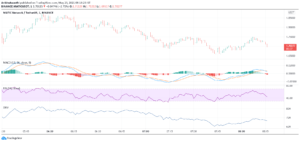Establishing a world record is one way of saying, “This is the best we can do as humans; now, let’s all try to beat it.” From baseball, and the Guinness Book to the Olympics, we are continually striving to lift more, jump higher, or move faster. In business, the ability to react and adapt more quickly than your competitor has value. In electronic trading, like no other market, they can precisely assign a dollar value to increases in speed. Faster compute speed can mean being first to the market, allowing a trader to be top in the order queue. Time is literally money, and in this highly competitive environment, every nanosecond counts. To put a fresh spin on the famous Gordon Gekko quote from the movie Wall Street…“Speed is Good!”

In 2017, electronic trading systems measured the network delay or latency between receiving a trade signal and processing the buy or sell order, also known as tick-to-trade time, often at just over a microsecond. These trading systems typically used ASIC-based Network Interface Cards (NICs) that support bypassing the operating system for trading application traffic and are built using off-the-shelf computer components.
Earlier in the decade, Solarflare (now part of Xilinx) filed several patents around a new method to reduce network latency, and these changes led to substantial improvements. So much so that several years ago the Securities Technology Analysis Center (STAC®), an organization that provides technology research and testing tools based on community-sourced standards, developed the new STAC-T0™ benchmark. The STAC-T0 benchmark is modeled after fast trading markets like futures and equities and is the absolute measure of how fast a trading platform can respond to a signal from the market over Ethernet, before accounting for the time taken by the trading logic.
We recently teamed up with LDA Technologies on a mission to set a new STAC-T0 benchmark record. We’re proud to announce that on May 21, 2020, STAC validated our STAC-T0 performance at a world record 24.2 nanoseconds*. For some perspective, 24.2 nanoseconds is equivalent to the time it takes a single photon of light to pass two parked cars.
“25 nanosecond data in, data out latency for the Xilinx and LDA electronic trading platform allows our ultra-low latency Raptor FPGA pre-trade risk management solution to reach previously unheard-of latencies.” – William Dallyn, Raptor, a product of Fusion Systems
When building a world-class trading system, you have to start with a substantial computational foundation, and in this case, its Lenovo’s newly announced SR665 dual-socket server with a pair of AMD® EPYC™ 7742 Scalable (Rome) processors. It offers unmatched I/O performance via 64 cores and 128 computational threads, clocked at up to 3.4 GHz, and you have a serious system for trading. It uses a Xilinx Onload®-enabled network adapter to connect with the exchange and set up the necessary TCP sessions.
 (Xilinx XtremeScale X2522 Ethernet Adapter Card)
(Xilinx XtremeScale X2522 Ethernet Adapter Card)
To execute trades using the absolute lowest latency platform, we installed an LDA Technologies SBM09P-3 HFT-Oriented FPGA Board, powered by the Xilinx UltraScale+ VU9P-3 FPGA and running LDA’s 644 MHz Trading Framework that includes Lightspeed v2 TCP and LDA’s 10G 644 MHz/16-bit MAC/PCS IP Cores. Built for trading, the LDA board features two jitter attenuators, a Stratum-3 class clock, and 576MB of ultra-fast SRAM. Although the test system was purpose-built, the trading system can easily be reproduced using a server platform and components that are readily available.
 (LDA Technologies SBM09P-3 Board powered by the Xilinx® Virtex™ UltraScale+ VU9P-3)
(LDA Technologies SBM09P-3 Board powered by the Xilinx® Virtex™ UltraScale+ VU9P-3)
The target of any trading system is to cut the tick-to-trade time. LDA has focused on removing any unnecessary delays in incoming signal processing by adding jitter attenuators to their FPGA boards. Using a jitter attenuator allows FPGA trading logic running on the board to synchronize with the Exchange by locking its reference clock to the one transmitted with the signal coming from the Exchange. This approach ensures that the valuable time is spent only on processing actionable data and not moving it across different clock domains.
So, as we ponder the significance of moving actionable data through a system in 24.5 nanoseconds, it might be best to consider how Peter Lankford, STAC founder, and executive director, summarized the industry in his first STAC-T0 report:
“While the communications effort is bounded by the speed of light, the computing effort is limited by the minimum possible scale of transistors and, perhaps ultimately, the divisibility of time itself. Thus, trading technology is simultaneously pushing toward the limits of both of Einstein’s great discoveries: relativity and quantum reality.”
We’re excited to see what the future holds for ultra-low-latency trading as technology continues to push the limits of silicon and even physics itself.
*Benchmark: STAC-T0.β1.HIGHRATE.B.ACTIONABLE.MIN. Subject to measurement error. For details see the complete STAC Report™ at www.STACresearch.com/XLX200514.



